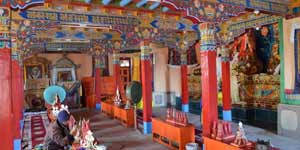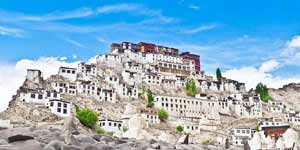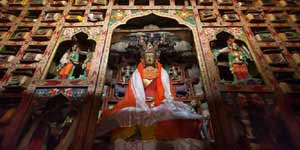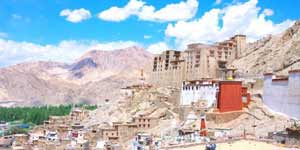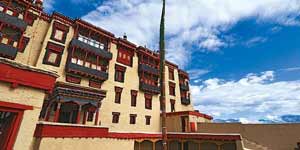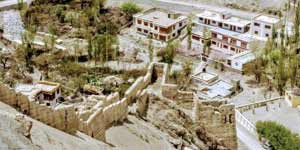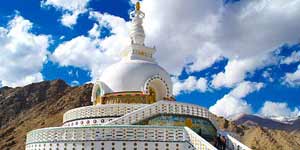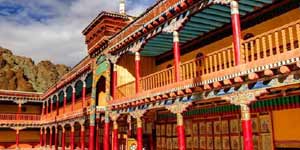
Shanti Stupa, Leh
Shanti Stupa is situated at a height of 4267 meters overlooking the Leh city, it gives a panaoromic view of surrounding snow capped mountains. Situated at a distance of about 5 km drive able road from the Leh city or one can reach here by climbing 500 steps . The location of Shanti Stupa is such that it is visible from all over Leh city.
It is built as a two level structure, a flight of stairs leads to the first level where a Dharmchakra (as in white strip of Indian national flag) with two deer on each side, features a central image of Lord Buddha in golden colour sitting on a platform turning the Dharmchakra wheel, the second level depicting the birth of Buddha, defeating of devils in meditation and death of Buddha along with many small images of meditating Buddha, all embossed in vibrant colours.
A white dome Stupa (Chorten) built on a Changspa, a steep hill, opposite the Leh Palace different in architecture from the Ladhakhi style gives a magnificent view at sunrise and sunset, it looks more beautiful at night illuminated in the white light. It was built by the Ladakh and Japanese Buddhists, Ladakhis offered voluntary labor, construction started in 1983 and it was inaugurated in August 1991 by His Holiness The Dalai Lama. It was built to promote world peace and prosperty and to commemorate the 2500 years of Buddhism.
Shanti Stupa is situated on a hilltop in Chanspa, Leh district, Ladakh, in the north Indian state of Jammu and Kashmir. Shanti Stupa as know Buddhist white-domed stupa. It was built in 1991 by Japanese Buddhist Bhikshu Gyomyo Nakamura .The Shanti Stupa holds the relics of the Buddha at its base, enshrined by the 14th Dalai Lama himself. Shanti stupa has provides beautiful and panoramic view of the surrounding landscape. This has become a primary reason for Shanti Stupa to become a popular tourist attraction, apart from its religious significance.
Situated at a height of 4,267 metres (13,999 ft), the stupa is located 5 kilometres (3.1 mi) from Leh - the former capital of Ladakh - on a steep hill facing the Leh Palace. The stupa can be reached by a drivable road or on foot using a series of 500 steep steps to the hilltop
The stupa is open for tourists between 5:00 a.m. and 9:00 p.m. Sunrise and sunset are considered to provide the best views from Shanti Stupa.
History of The Shanti Stupa : The Shanti Stupa was built by both Ladakh and Japanese Buddhists. It was made as part of Nichidatsu Fujii’s mission to resurrect Buddhism back in India in 1914 by building Peace Pagodas and temples all over the world. It was in 1983, when the Ladakhi and Japanese Buddhists offered voluntary help to construct the Shanti Stupa that began under the supervision of Kushok Bakula, a lama of Ladakh from New Delhi and Bhikshu Gyomyo Nakamura, a Japanese Buddhist. In 1984, the Prime minister of India, Smt Indira Gandhi, sanctioned the construction of a road to the Stupa. And In 1991, It was inaugurated by the 14th and current Dalai Lama - Tenzin Gyatso.
Location : Located just at a distance of 5 km from Leh, this place is surrounded by traditionally built houses of the locals and snow covered mountains. It is one of the major tourist attractions of Leh and its mesmerizing to watch the beautiful sunrise and sunset from this place which makes the journey to this place unforgettable and memorable.
Getting There- As this place is located at an altitude of 11,841 ft, you can reach here by car or by climbing a series of around 500 steps to the hilltop. One of the closest landmarks to the Shanti Stupa is the palace in Leh.
Timings: The Shanti Stupa is open for visitors from 5 am to 9 pm on all days of the week for travellers coming from all across the world.
Leh Ladakh Monuments
Leh Ladakh Monuments For any traveller Ladakh is a dream destination. Serene Valleys, high mountain passes, picturesque villages, undulating plains, pristine alpine lakes and snow-clad Himalayan peaks; beauty of this mysterious land remains largely unchanged to this day. The tranquility and serenity of the place attracts many holiday seekers and nature lovers from all over the world Of the world to rest in the lap of nature. With its variety of trekking, mountain-climbing, mountain biking, river rafting adventure activities; the place is also a favorite among adventure junkies. On top it all, the sheer abundance of wildlife in Ladakh offers wildlife enthusiasts a great environment for bird watching and nature exploration, too, who throng on explore here the treasures of wildlife hidden in the reaches of Himalayas. When you are planning a trip to Ladakh, Where to go and what to see in Leh-Ladakh; these are the very first questions that will surely cross your mind. With this blog, we've tried to provide you with a curated travel information guide for Leh-Ladakh trip listing the top 50 attractions to be visited during your Ladakh vacation. This guide will also help you jot down the best travel plan for the Leh-Ladakh trip so that you can explore each and every corner of this beautiful land.


